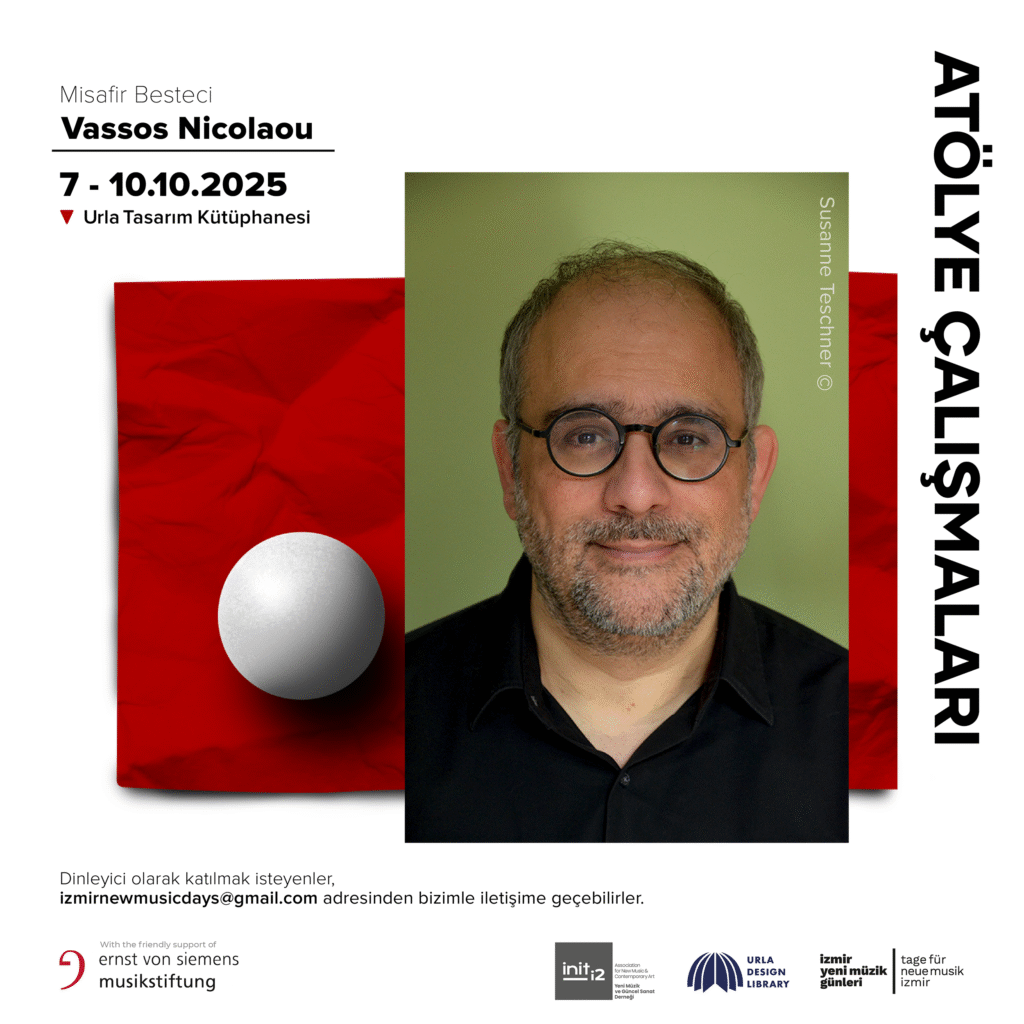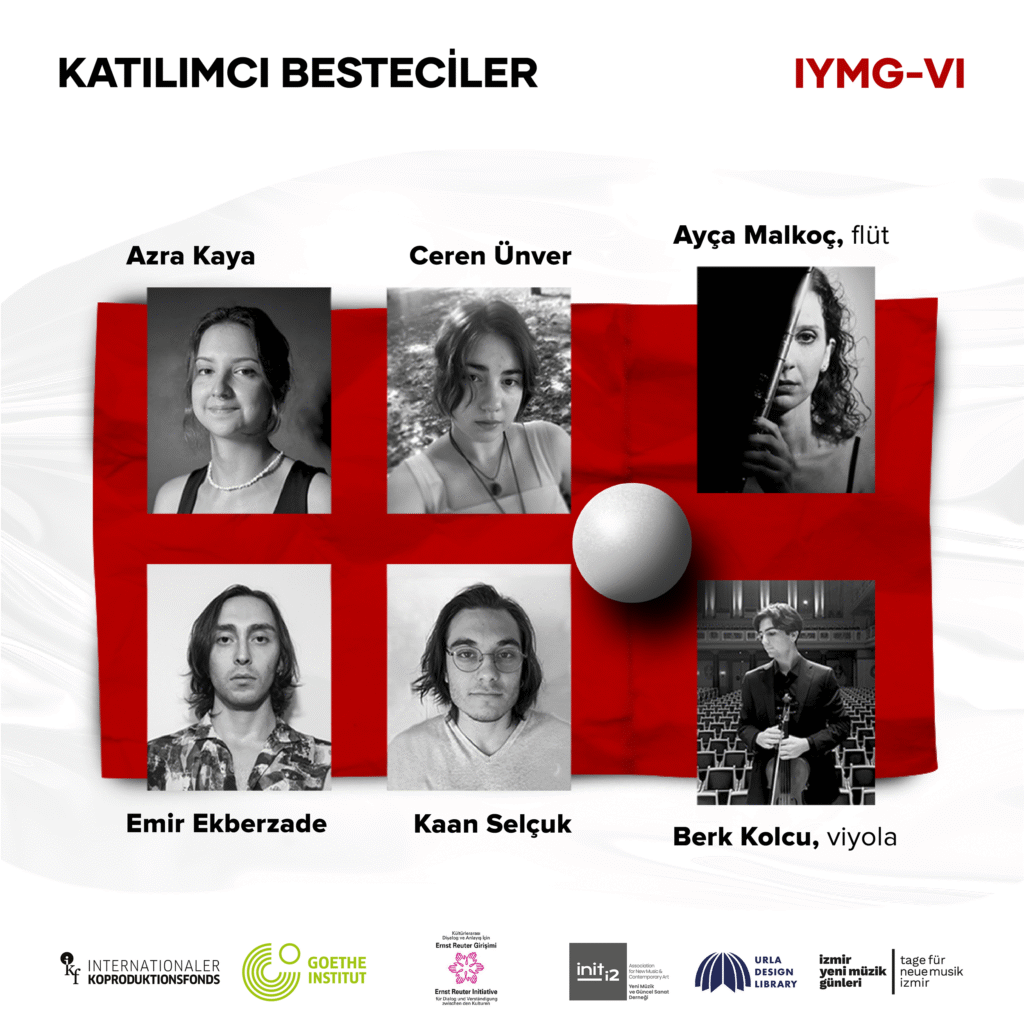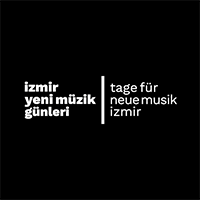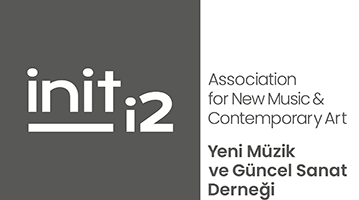İZMİR NEW MUSIC DAYS VI, 7-12 Oct. 2025

The sixth edition of İzmir New Music Days opens on October 7 with workshops led by the guest group Ensemble Hand Werk [hand werk] and composer Vassos Nicolaou. Featuring the active participation of four young composers, and musicians, the workshops will culminate on October 12 with concerts by Duo Aspera and Ensemble [hand werk] at the Small Hall of the Ahmed Adnan Saygun Art Center. We are especially proud that this year’s project—developed in collaboration with Ensemble [hand werk] and New Music and Contemporary Art (init-i2)—is generously supported by the Goethe-Institut International Koproduktionsfonds, Ernst von Siemens Music Foundation, Goethe-Institut İzmir, and the Austrian Cultural Forum.
Young composers who would like to attend the workshops as auditors can contact us via izmirnewmusic@gmail.com





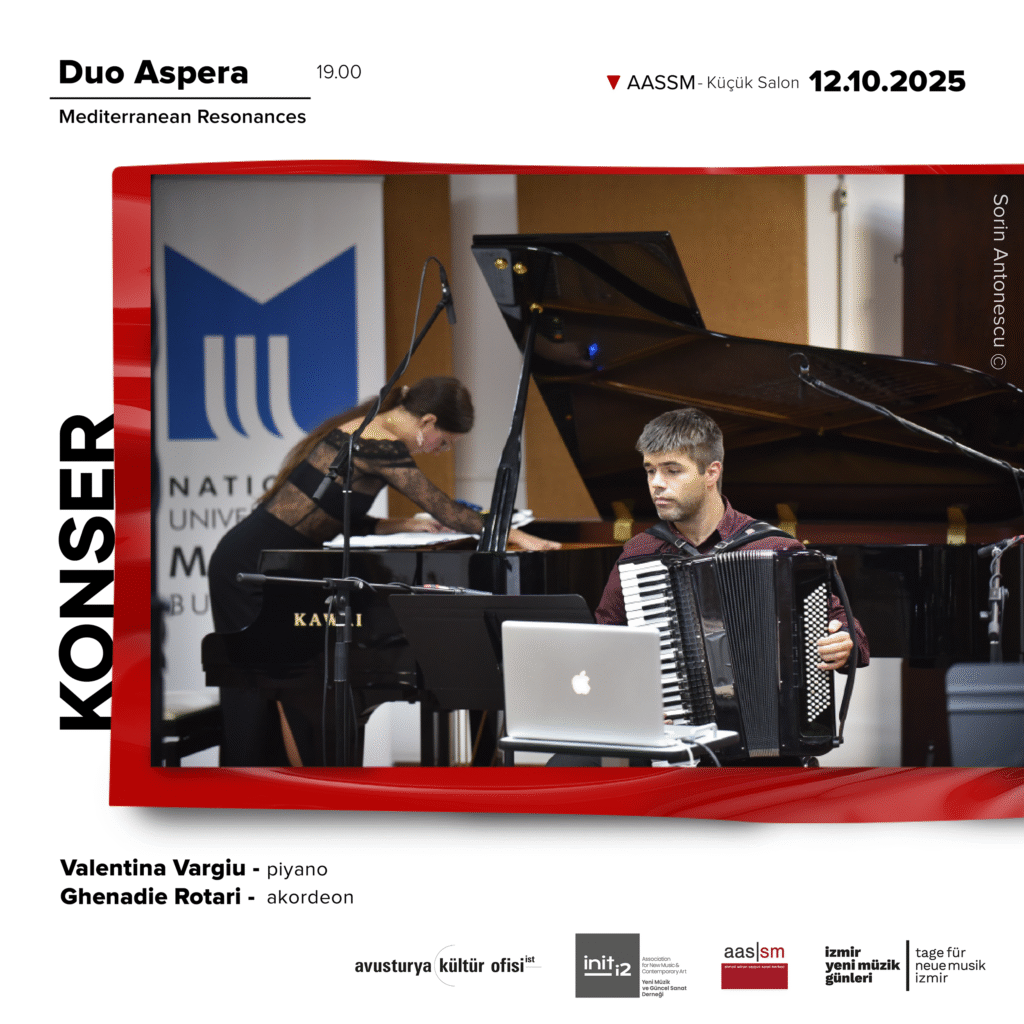

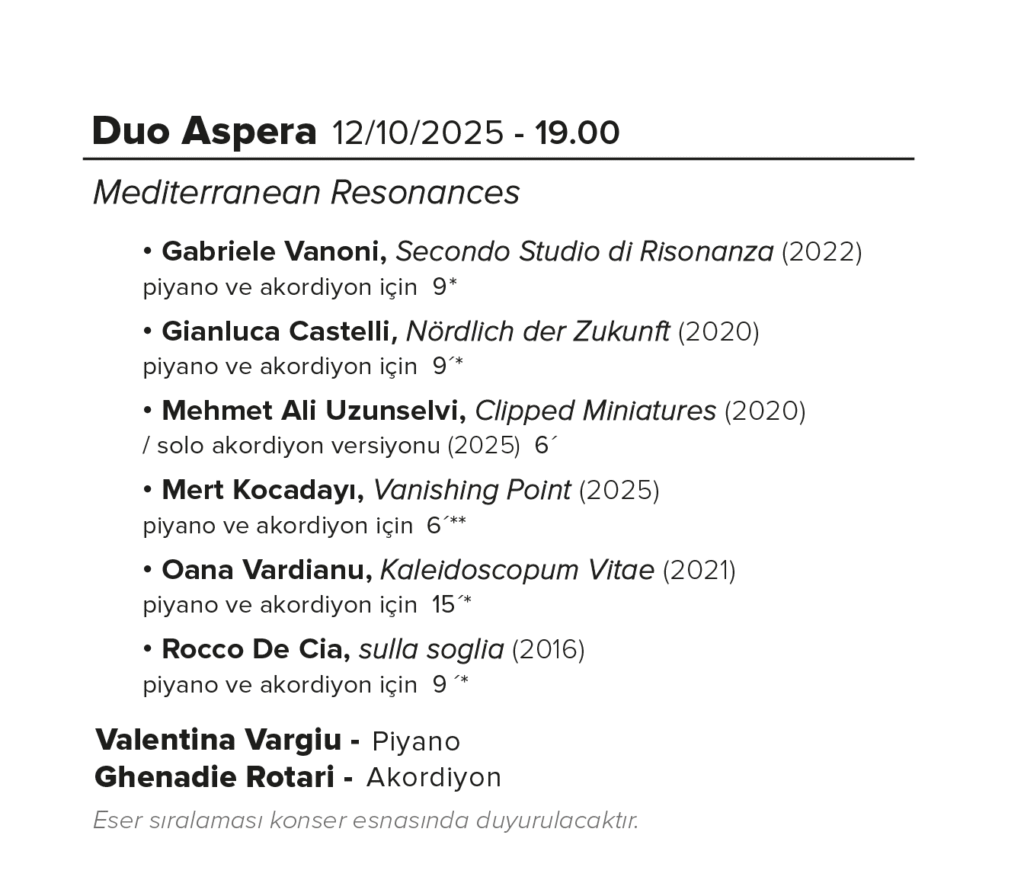

PROGRAM NOTES
Gabriele Vanoni – Secondo Studio di Risonanza (2022)
“Secondo Studio di Risonanza was written for Duo Aspera and is part of a series of pieces that explore the blending of sonorities between different instruments, examining how each instrument’s resonance can itself become a compositional material from which the entire ensemble can draw. In this work, the piano and accordion sometimes merge, at other times ‘chase’ each other, yet always contribute to the creation of a distinct sonority and resonance.”


Gianluca Castelli – Nördlich der Zukunft (2020)
In the Rivers North of the Future
I cast the net, which you
hesitantly weight
with shadows stones
wrote.
– Paul Celan


Mehmet Ali Uzunselvi – Clipped Miniatures (2020)
This piece is based on residual characters drawn from trimmed fragments of various improvisation sessions undertaken by Uzunselvi during the pandemic period. These leftover fragments resurface and gain new meaning within the framework of the composer’s long-developing Gradual Reduction concept, evolving into a form shaped not only by the nature of free association inherent in improvisation but also by the voids and momentary projections that characterize the resulting structure.
Almost every figure, motif, or microstructural unit in the work is shaped through a pointillistic language grounded in principles of reduction or trimming. In this respect, the piece turns away from gesture and coherence, instead focusing on an aesthetic of the void and the stain—on the tension between absence and trace.
In addition to the work’s versions performed using various quarter-tone tuning systems created with virtual instrument software based on sampling and physical modeling, the piece also exists in fixed media versions, structured according to the composer’s Parallel Composition concept.


Mert Kocadayı – Vanishing Point (2025)
Vanishing Point reflects the psychological dislocation of the artist who continues to create while knowing that they cannot stop the destruction unfolding beyond the space of their artistic practice. The work emerges from a tension between witnessing and inaction, between sound and the unspeakable. It speaks not only to a visual or scientific idea where all lines (and principles) converge and disappear-but also to the fading sense of meaning in creating art under unbearable conditions. This music is not a protest, but a personal shelter made of successive moments; the outcome of trying to continue creating in an age of collapse, and a helpless observation of everything around us that terrifies us.


Oana Vardianu – Kaleidoscopum Vitae (2021)
Kaleidoscopum vitae portrays the course of an ordinary human life, translated into music. Its four movements correspond to four stages of human development:
- Green child…?
- Meaning… Seeker.
- I said grown-up, not inflexible!
- Growing old… Heavy burden…
The title, Kaleidoscopum vitae, reflects the ever-shifting human perspective, which inevitably changes throughout life. Our perception of events can differ radically, even when the circumstances themselves remain identical. By combining accordion and piano, the work creates an ‘orchestral’ richness of sound, while at the same time exploring unusual textures. The piece draws on the accordion’s wide palette of registers and extended techniques, revealing both the serious and the playful sides of life itself.


Rocco de Cia – sulla soglia (2016)
“The idea of sulla soglia (On the Threshold) came to me as I imagined the piano sound as the protagonist, with the accordion as its shadow—a delicate halo, a trail that becomes perceptible only once the piano’s sound has faded. Gradually, the accordion grows more present until the two instruments assume equal importance, merging together.
Some time after writing the piece, a curious thing happened: a Chinese student I met at the University of Bologna listened to a recording of sulla soglia by Ghenadie Rotari and Valentina Vargiu. She told me that, while listening, she imagined Pangu, the primeval deity of Chinese mythology, who separates the sky from the earth and maintains the balance between yin and yang. I had not known the story of Pangu, and this unexpected association struck me; ever since, whenever I hear sulla soglia, I recall it with a certain satisfaction.”


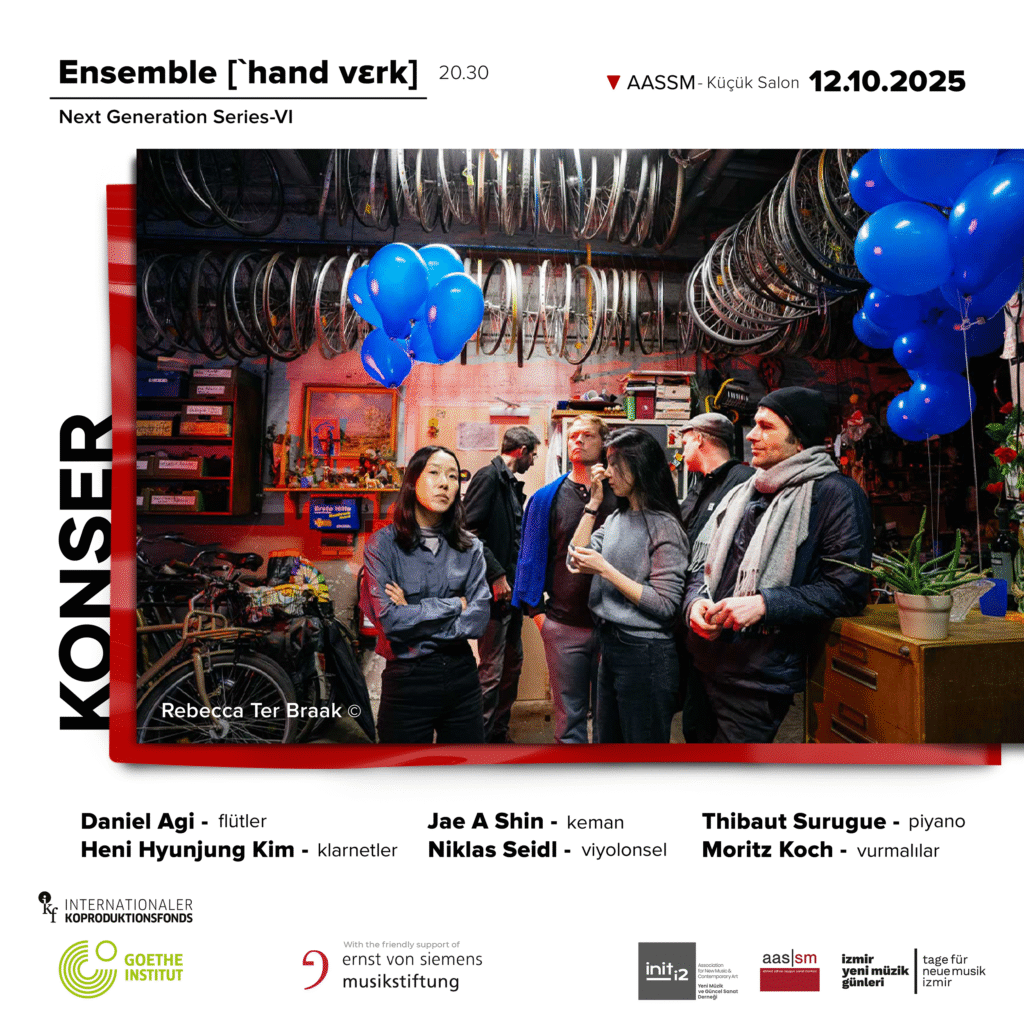

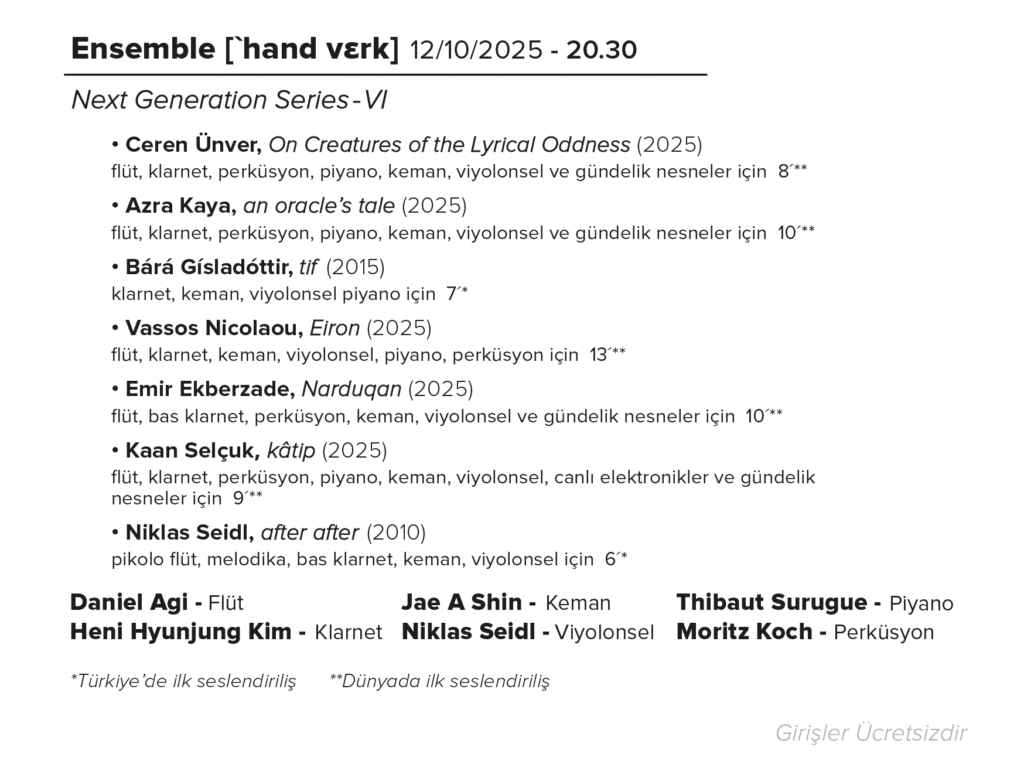

PROGRAM NOTES
Ceren Ünver, On Creatures of the Lyrical Oddness (2025)
for flute, clarinet, piano, percussion, violin violoncello and makeshift instruments 8’
On Creatures of the Lyrical Oddness/ Lirik Garipliğin Yaratıkları Üzerine is an ensemble piece that aims to approach the audience as readers. Rather than a storyline, the piece tries to achieve the specific feeling of consuming literature that focuses on fantastic creatures of “lyrical oddness” like fairies, nymphs and myths. With the illustrative images of it, which are subjective in shape but remain the same in colour, the composer tries to bring the abstract visual sense of literary fiction to sight through sound. The ensemble consists of flute, clarinet, piano, violin, cello and small percussion instruments, including “makeshift instruments” (such as a desk lamp and a plastic tube). The music is based on phrases focusing on the transformations between inharmonicity and harmonicity to create the magical sound world. For the composer, this piece is a self-discovery of the sense of artistic unity, such as the images of literature, the sound of sight and the narrative of the music.


Azra Kaya, an oracle’s tale (2025)
for flute, bass clarinet, percussion, piano, violin, violoncello and makeshift instruments 9’
The composition is inspired by Claros Ancient City, one of the three famous centers of prophecy in the world. The city was built as a temple for Apollo, and during the Hellenistic period, the worship of Dionysos also gained importance. In the city, Apollo’s messages and prophecies were shared with the people through rituals. At the end of these nocturnal rituals, Dionysos’ priests acted as intermediaries to deliver the messages. The composition depicts the message of a ritual culminating in prophecy.


Emir Ekberzade, Narduqan (2025)
for flute, bass clarinet, percussion, violin, violoncello and makeshift instruments 10’
Narduqan, in the northern hemisphere, marks the winter solstice and the longest night of the year. It symbolizes the peak of darkness and the moment when light begins to grow again. Rooted in the Mithraic tradition, this ancient ritual embodies the rebirth of the sun and the triumph of light over darkness. During the Mithraic era, it acquired a theological framework; in the Zoroastrian period, it gained mythological depth through the cosmic opposition of Ahriman and Ahura Mazda. After the advent of Islam, it continued to endure through poetry, literature, and communal celebrations. This ritual is observed in the northern hemisphere, particularly in some regions of Türkiye, Iran, Azerbaijan, and the northern areas of Central Asia, and is celebrated by the peoples living in these cultures. Among some Turks, this night is known as Nardugan; it means the sun’s rebirth. Beginning on December 21, when the sun reaches its lowest point, this period culminates on December 25, when light starts to rise again, symbolizing “rebirth.” In this music, what comes to the forefront is the idea that the conflict arises from the essence of Narduqan. The tension between darkness and lht, night and day, death and rebirth resonates in its texture. The aim is to let the listener hear not only these contrasts but also the cultural and cosmic meanings carried from ancient times to the present.


Kaan Selçuk, kâtip (2025)
for flute, bass clarinet, percussion, piano, violin, violoncello, live electronics and makeshift instruments 9’
The main material of the work is built upon Olivier Messiaen’s Thème de Dieu [Theme of God]. This theme appears throughout the piece in various transformations. Its continuous metamorphosis—like a random mutation—questions the notion of God as the ultimate and perfect being. Makeshift instruments, the notebook, and the pen constantly remind us, through the sounds they produce, that these reflections on God reach us via mythological and written culture. Although the sections share various connections, they do not resolve linearly into each other. Here, musical ideas and sectıons do not represent themselves directly, but rather serve as compressed representations of the larger musical (or extra-musical) concepts to which they belong.


Niklas Seidl, after after (2010)
for melodica, piccolo flute, bass clarinet, violin, violoncello
The piece deals with two ideas of making music that interact with each other during the piece. The bass clarinet and violin perform a fine network of specially selected short and soft sounds, whereas the melodica and the piccolo insist on a single note most of the time. These simple oppositions present two intensities: the texture of sounds on the border to silence as an intellectual reflection and the strength of a simple tone that gets its tension only by its high energy and repetition.
The word after is an interesting term, because it separates time – maybe randomly – in two sections. There must have been a before and possibly an action in between. The piece is mirrored in the middle, but in a distorted manor. The first part takes place after something has already happenend, so the second part tries to find the after after the after.


